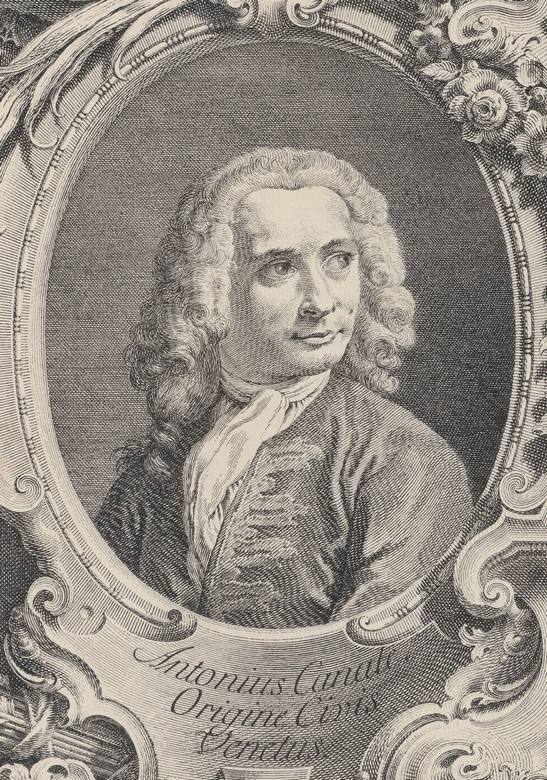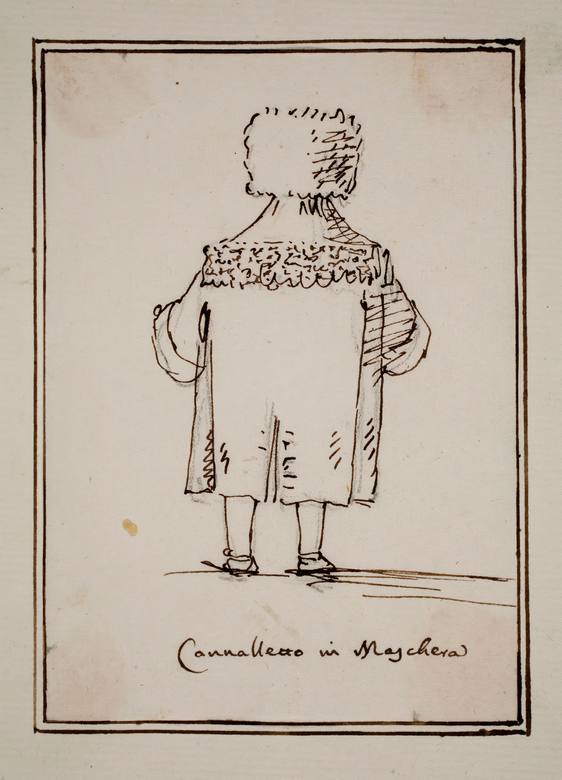
Why the name "il Canaletto"
Son of Canal or a short guy?
There are very few images of Canaletto the man, and just one is by all historians accepted, the one drawn by Giovanni Battista Piazzetta that we find on the frontispiece of the Prospectus Magni Canalis Venetiarum by Antonio Visentini, printed for the first time in 1735, and of course A.M. Zanetti's caricature, and it's from the back and suggests the idea of a short guy.
Even his self-portrait in London (and Benjamin West's drawing) are put in doubt, although they give a very strong impression of similitude.
Antonio Canal becomes "il Canaletto"
Giovanni Antonio Canal along his life signed or wrote his name in several ways: Canal, da Canal, Canale, Canalelo, Canaletti and Canaletto.
We also know that every now and then Canaletto used the pampering appellation "il Tottino".
But "Canaletto" is the name he adopted in the end, very likely because everybody was referring to him with this name.
In Italy there has always been the habit of using a pampering or diminutive as a desinence of a name to define or connect a son to his father.
And Venetians used (and still do) this way of placing the ...eto, or ...ino after a name to give it a gentle pampering feeling.
Or maybe referring to something/somebody of small size, but also of a newer origin, like the son of ... Canal for instance. We have no idea if Bernardo Canal was a big strong guy or not, but for sure the Canaletto was the new one.
And it may become especially true when the son is following his parent in his work career, and becomes a follower in his father's profession and life choice.
Which was supposed to be Canaletto's future when he was young and searching around, ... but it went the other way around ...
... but was he a short guy in the end?
All the hypotheses formulated are suggesting that Canaletto wasn't necessarily a short guy ... but very likely he was.
The carnival caricature from Zanetti already gives an idea, and we have a testimony from the Reverend Edward Hinchliffe, who wrote that his grandfather John Hinchliffe, who was taking in 1760 the young John Crewe to make his Grand Tour, and while they are in Venice:
"When the two travelers were at Venice ... they chanced to see a little man making a sketch of the Campanile, in S' Mark's place: Hinchcliffe took the liberty - not an offensive one abroad, as I myself can testify - to look at what he was doing.
Straightway he discovered a master-hand, and hazarded the artist's name, "-Canaletti-". The man looked up and replied "-mi conosce-" (you know me).
Thereupon a conversation ensued, and Canaletti pleased to find so enthusiastic a judge of drawing, invited Hinchcliffe to his studio, who waited upon him there on the following day, and inspected his paintings and drawings ..."
Canaletto promptly made a present to him of the first drawing we see here on the right side, and John Hinchliffe - as it may easily be imagined - bought a painting from him.
![Antonio Visentini - Angela Baroni: [1833] - Frontespizio con i ritratti di Antonio Canal e Antonio Visentini - Etching / burin](../images_db/Antonio-Visentini_1833__e049_Frontespizio-con-i-Ritratti-di-Antonio-Canal-e-Antonio-Visentini-S-FN43914.jpg)



![attributed to Canaletto: [1746] - A Self-Portrait in London with St Pauls Cathedral in the background - Oil on canvas - Private Collection, Anglesey Abbey](../images_db/Canaletto-1746--x016-A-self-portait-with-Saint-Pauls-in-the-Background-271330.jpg)
![Benjamin West: [1753-1820] - Portrait of Antonio Canaletto - Drawing - Red chalk - Ashmoleam Museum, Oxford](../images_db/Benjamin-West-1753-1820--x020-Portrait-of-Antonio-Canaletto--Ashmoleam-Museum-Oxford--WA1924.9.349-WA1924.9.349-L-gp.jpg)
![Canaletto: [maybe 1760] - Piazza S. Marco - looking East - Drawing - Pen and brown ink - Private Collection, The Lord O’Neill](../images_db/Canaletto_1760maybe__d250_Piazza-S.-Marco-looking-East-b-337-gp2.jpg)
![Canaletto: [ca. 1755-65] - Piazza San Marco, Venice, seen from the southwest - Drawing - Sketch in graphite or black chalk, pen in brown, brush in grey - Rijksmuseum, Amsterdam](../images_db/Canaletto_1755-65__d258_Piazza-San-Marco-Venice-seen-from-the-southwest_01-Rijksmuseum.jpg)